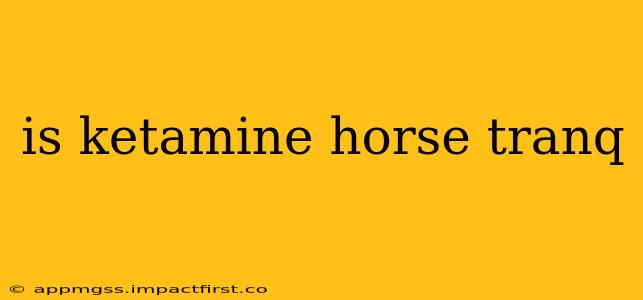Is Ketamine "Horse Tranq"? Understanding the Misinformation
The term "horse tranq" is often used to refer to a dangerous street drug combination involving xylazine, a veterinary tranquilizer, sometimes mixed with fentanyl or other opioids. Ketamine is not "horse tranq," though both are powerful drugs with sedative effects. The confusion stems from the similar sedative properties and the fact that both can be misused. However, they are distinct substances with different chemical structures and effects. Let's clarify the differences and address common misconceptions.
What is Ketamine?
Ketamine is a dissociative anesthetic. This means it alters perception of reality, producing feelings of detachment from one's body and surroundings. While it has legitimate medical uses as an anesthetic and in the treatment of depression, it's also a drug of abuse. Its effects can vary widely depending on the dosage and individual factors. Common effects include:
- Dissociation: A feeling of detachment from one's body and environment.
- Hallucinations: Visual and auditory distortions.
- Amnesia: Difficulty remembering events that occurred while under the influence.
- Euphoria: A feeling of intense pleasure or well-being.
- Sedation: Drowsiness and slowed reactions.
What is Xylazine ("Horse Tranq")?
Xylazine is a non-opioid veterinary tranquilizer used to sedate large animals like horses and cattle. It's increasingly being mixed with other drugs, particularly fentanyl, in the illegal drug market. This combination is extremely dangerous because:
- Xylazine is not an opioid: Naloxone (Narcan), the standard treatment for opioid overdose, is ineffective against xylazine overdose.
- Xylazine's effects: It causes severe sedation, respiratory depression, and can lead to necrotic wounds (skin lesions and tissue damage).
- Increased overdose risk: The combination of xylazine and fentanyl greatly increases the risk of fatal overdose.
What are the Key Differences Between Ketamine and Xylazine?
| Feature | Ketamine | Xylazine |
|---|---|---|
| Type of Drug | Dissociative anesthetic | Non-opioid veterinary tranquilizer |
| Medical Use | Anesthesia, depression treatment | Sedation in large animals |
| Overdose Treatment | Varies, supportive care often needed | No specific antidote, supportive care needed |
| Street Use | Used recreationally, sometimes mixed with other drugs | Often mixed with opioids, especially fentanyl |
| Necrotic Wounds | Not a primary effect | Significant risk of necrotic wounds |
Is Ketamine Mixed with Other Drugs?
While ketamine is sometimes misused on its own, it can also be combined with other substances, such as alcohol or other drugs. These combinations can significantly increase the risk of adverse effects and overdose.
What are the dangers of misusing ketamine?
Misusing ketamine can lead to a range of harmful consequences, including:
- Overdose: High doses can cause respiratory depression, coma, and death.
- Mental health problems: Ketamine can worsen existing mental health conditions or trigger new ones.
- Addiction: Regular ketamine use can lead to dependence and addiction.
- Physical health problems: Long-term use can damage the bladder, liver, and kidneys.
In conclusion: Ketamine and xylazine are distinct drugs with different effects and risks. The term "horse tranq" refers specifically to xylazine, often mixed with other dangerous substances, and should not be used interchangeably with ketamine. If you or someone you know is struggling with substance abuse, please seek help immediately. There are resources available to provide support and treatment.
